| |||||
| Decades: | |||||
|---|---|---|---|---|---|
| See also: | |||||
Events from the year 1916 in Italy.
| |||||
| Decades: | |||||
|---|---|---|---|---|---|
| See also: | |||||
Events from the year 1916 in Italy.

Italy entered World War I in May 1915, declaring war on Austria-Hungary. The Royal Italian Army stands under command of Chief of Staff and Field Marshall Luigi Cadorna. The Isonzo is the main battlefield on the Italian Front. The goal of these offensives was the fortress of Gorizia, the capture of which would permit the Italian armies to pivot south and march on Trieste. The frequency of offensives, one every three months, was higher than demanded by the armies on the Western Front. Italian discipline was also harsher, with punishments for infractions of duty of a severity not known in the German, French, and British armies.

The history of Tyrol, a historical region in the middle alpine area of Central Europe, dates back to early human settlements at the end of the last glacier period, around 12,000 BC. Sedentary settlements of farmers and herders can be traced back to 5000 BC. Many of the main and side valleys were settled during the early Bronze Age, from 1800 to 1300 BC. From these settlements, two prominent cultures emerged: the Laugen-Melaun culture in the Bronze Age, and the Fritzens-Sanzeno culture in the Iron Age.
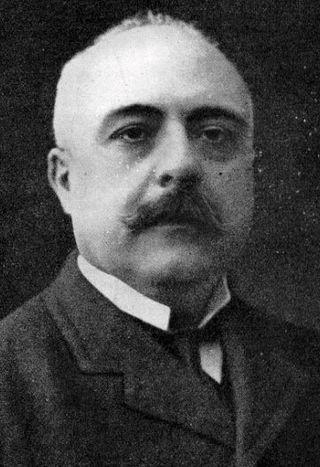
Antonio Salandra was a conservative Italian politician, journalist, and writer who served as the 21st prime minister of Italy between 1914 and 1916. He ensured the entry of Italy in World War I on the side of the Triple Entente to fulfil Italy's irredentist claims.

The Second Battle of the Piave River, fought between 15 and 23 June 1918, was a decisive victory for the Italian Army against the Austro-Hungarian Empire during World War I, as Italy was part of the Allied Forces, while Austria-Hungary was part of the Central Powers. Though the battle proved to be a decisive blow to the Austro-Hungarian Empire and by extension the Central Powers, its full significance was not initially appreciated in Italy. Yet Erich Ludendorff, on hearing the news, is reported to have said he 'had the sensation of defeat for the first time'. It would later become clear that the battle was in fact the beginning of the end of the Austro-Hungarian Empire.
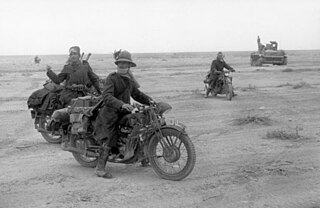
The 1st Army was a Royal Italian Army field army, in World War I, facing Austro-Hungarian and German forces, and in World War II, fighting on the North African front.

The Italian front was one of the main theatres of war of World War I. It involved a series of military engagements along the border between the Kingdom of Italy and Austria-Hungary from 1915 to 1918. Following secret promises made by the Allies in the 1915 Treaty of London, the Kingdom of Italy entered the war on the Allied side, aiming to annex the Austrian Littoral, northern Dalmatia and the territories of present-day Trentino and South Tyrol. The front soon bogged down into trench warfare, similar to that on the Western Front, but at high altitudes and with extremely cold winters. Fighting along the front displaced much of the local population, and several thousand civilians died from malnutrition and illness in Italian and Austro-Hungarian refugee camps.
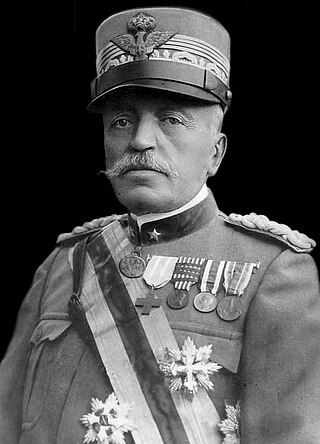
Marshal of Italy Luigi Cadorna, was an Italian general, Marshal of Italy and Count, most famous for being the Chief of Staff of the Italian Army from 1914 until 1917 during World War I. During this period, commanding the Italian army on the Alpine front and along the Isonzo river, he acquired a reputation for rigid discipline and the harsh treatment of his troops. Cadorna achieved successes in containing the Strafexpedition and capturing Gorizia but, following a major defeat at the Battle of Caporetto in late 1917, he was relieved as Chief of Staff.

The Sixth Battle of the Isonzo, better known as the Battle of Gorizia, was the most successful Italian offensive along the Soča (Isonzo) River during World War I.

The Second Battle of the Isonzo was fought between the armies of the Kingdom of Italy and those of Austria-Hungary in the Italian Front in World War I, between 18 July and 3 August 1915.

The Third Battle of the Isonzo was fought from 18 October through 4 November 1915 between the armies of Italy and Austria-Hungary.
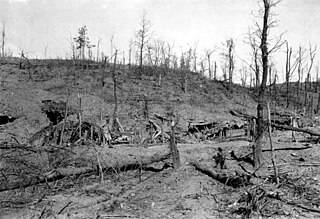
The Südtirol Offensive, also known as the Battle of Asiago or Battle of the Plateaux, wrongly nicknamed Strafexpedition "Punitive expedition", was a major offensive launched by the Austro-Hungarians on the territory of Vicentine Alps in the Italian Front on 15 May 1916, during World War I. It was an "unexpected" attack that took place near Asiago in the province of Vicenza after the Fifth Battle of the Isonzo.

The Battle of Doberdò took place in August 1916, fought by the Kingdom of Italy and Austria-Hungary. The Austro-Hungarian army was primarily made up of regiments filled with Hungarians and Slovenians. The battle was a part of the Sixth Battle of the Isonzo, and occurred in a strategic area: the most western edge of the Karst Plateau. The Italians had already conquered the lowland area surrounding Monfalcone and Ronchi, and attempted to push over the Karst Plateau to seize control of the major road that linked the city of Trieste, with its important port, to Gorizia. After fierce combat, and sustaining heavy casualties, the Italian forces secured victory, forcing the Austro-Hungarian forces to retreat, and capturing Gorizia.
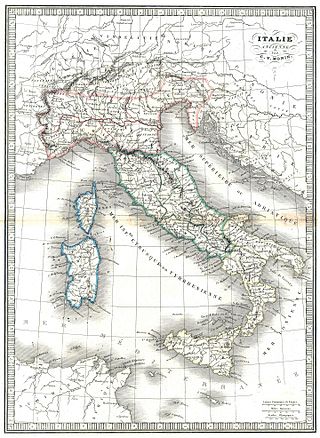
Although a member of the Triple Alliance, Italy did not join the Central Powers – Germany and Austria-Hungary – when the war started with Austria-Hungary's declaration of war on Serbia on 28 July 1914. In fact, the two Central Powers had taken the offensive while the Triple Alliance was supposed to be a defensive alliance. Moreover the Triple Alliance recognized that both Italy and Austria-Hungary were interested in the Balkans and required both to consult each other before changing the status quo and to provide compensation for whatever advantage in that area: Austria-Hungary did consult Germany but not Italy before issuing the ultimatum to Serbia, and refused any compensation before the end of the war.

The Fourth Battle of the Isonzo was fought between the armies of Kingdom of Italy and those of Austria-Hungary on the Italian Front in World War I, between 10 November and 2 December 1915.

The Fifth Battle of the Isonzo was fought from March 9–15, 1916 between the armies of the Kingdom of Italy and those of Austria-Hungary. The Italians had decided to launch another offensive on the Soča (Isonzo) River.

The Eighth Battle of the Isonzo was fought October 10–12, 1916 between Italy and Austria-Hungary.

The Ninth Battle of the Isonzo was an Italian offensive against Austria-Hungary in the course World War I. Including a triumvirate of battles launched after the Italians' successful seizure of Gorizia in August 1916 to extend their bridgehead to the left of the town, it ended in further failure for the Italian Chief of Staff Luigi Cadorna.

The Tenth Battle of the Isonzo was an Italian offensive against Austria-Hungary during World War I.

The Battles of the Isonzo were a series of twelve battles between the Austro-Hungarian and Italian armies in World War I mostly on the territory of present-day Slovenia, and the remainder in Italy along the Isonzo River on the eastern sector of the Italian Front between June 1915 and November 1917.
Events from the year 1917 in Italy.
Events from the year 1915 in Italy.